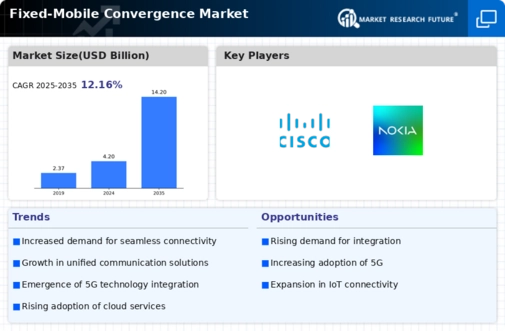Top Industry Leaders in the Fixed Mobile Convergence Market

Competitive Landscape of the Fixed-Mobile Convergence Market
The global fixed-mobile convergence (FMC) market is experiencing significant growth, driven by the increasing demand for seamless connectivity across various devices and services. This trend is attracting major players and new entrants, creating a competitive landscape marked by innovation and strategic diversification.
Key Players:
- Cisco (US)
- Ericsson AB (Sweden)
- Nokia (Finland)
- Huawei Technologies Co.Ltd (China)
- ZTE Corporation (China)
- Brunswick Corporation
Strategies Adopted:
- Bundled offerings: Bundling voice, data, and mobile services into single, discounted packages is a common strategy used by established players to attract and retain customers. This approach provides convenience and value to consumers, while strengthening customer loyalty.
- Network convergence: Leading players are investing heavily in network infrastructure upgrades to seamlessly integrate fixed and mobile networks. This allows them to offer seamless experience across various devices and locations.
- Strategic acquisitions: Companies are engaging in mergers and acquisitions to expand their reach and gain access to new technologies and markets. This helps them achieve economies of scale and improve their competitive position.
- Investment in next-generation technologies: Major players are actively investing in cutting-edge technologies like 5G and IoT to enhance network capacity and offer new services like connected homes and smart cities. This positions them well for future market growth.
- Partnerships and collaborations: To capitalize on emerging trends and reach new markets, companies are forming strategic partnerships and collaborations with other players in the ecosystem. This allows them to share resources, expertise, and develop innovative solutions.
Factors for Market Share Analysis:
- Subscriber base: The number of subscribers a company has for its FMC services is a key indicator of its market share.
- Average revenue per user (ARPU): ARPU measures the average revenue generated per subscriber, reflecting the company's pricing strategy and customer value proposition.
- Network coverage: The extent of a company's network coverage determines its reach and ability to attract subscribers in different regions.
- Brand reputation: A strong brand reputation and customer loyalty are crucial for attracting and retaining customers in a competitive market.
- Innovation and service differentiation: Companies that offer unique and innovative FMC services are better positioned to attract market share and achieve higher ARPU.
New and Emerging Companies:
Several new companies are entering the FMC market with innovative offerings and disruptive business models. These include:
- Mobile virtual network aggregators (MVNAs): MVNAs act as intermediaries between MVNOs and network operators, enabling them to offer customized and flexible mobile services.
- Cloud-based FMC providers: Companies like RingCentral and Mitel are offering cloud-based FMC solutions that provide seamless integration of voice, messaging, and video conferencing tools.
- Digital-only mobile operators: These operators offer mobile services exclusively online, eliminating the need for physical stores and reducing operational costs.
Current Company Investment Trends:
Companies are investing heavily in the following areas:
- Network infrastructure upgrades: As demand for data and video increases, companies are upgrading their networks to handle higher bandwidth and provide faster speeds.
- Next-generation technologies: 5G and IoT are key areas of investment for companies, as they offer opportunities for new service offerings and revenue streams.
- Security and privacy: With increasing cyber threats, companies are investing in robust security solutions to protect customer data and privacy.
- Customer experience: Companies are focusing on improving the customer experience through personalized service, self-service portals, and easy-to-use applications.
September 2023,Cisco acquired Splunk Inc., a leader in cybersecurity and observability. This mega acquisition will bring two of the most powerful innovation engines to create one of the largest software companies globally.
Nokia launched Network as a Code platform that accelerates the network programmability and monetization.
Recent DevelopmentApril 2023 saw a better integration of the latest technologies required for fixed mobile collaboration. The new technology integration in the Fixed-Mobile convergence allows better remote connectivity even in remote locations.
Network as Code, a new technology by Nokia is developed to hasten network programmability and monetization. With this, developers can access streamlined network capabilities through the Nokia Network as Code platform and developer site, which can be quickly incorporated into apps.
The Network as Code platform supports Nokia's strategic goal of advancing new business models and maximizing the benefits that networks can provide in terms of productivity, creativity, sustainability, and teamwork.
In order to collaborate on an ecosystem project leveraging the DISH 5G cloud-native network and Nokia's Network as Code platform, the two companies have signed a memorandum of understanding.









